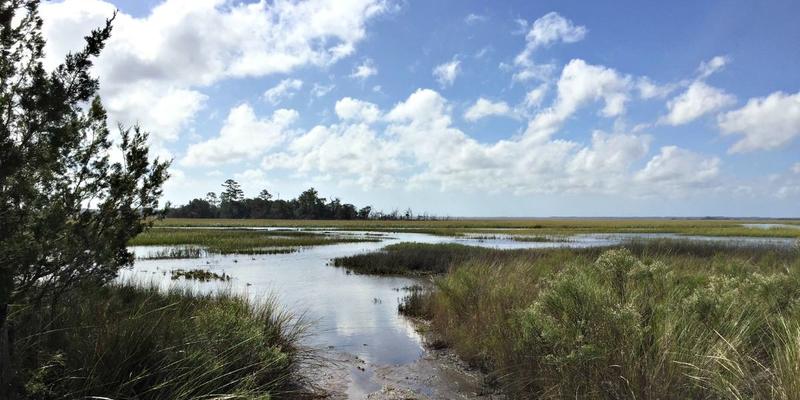
On occasion, I like to walk in a forest rather than paddle a kayak. On this windy, chilly day, the idea of a walk in a protected forest was much more appealing than a paddle on the open water. I had never been to the new Charleston County Park in Meggett, so I packed a lunch, grabbed my dog and some warm clothes and set out to visit it. There is a half-mile entrance path, which leads to a variety of well-marked trails within the 400+ acre preserve. Since I wanted to walk for a few hours, I choose the red-green-blue trail combination.(see https://ccprc.com/DocumentCenter/View/16071/Meggett-County-Park-Trail-Map)
Much of the entrance path is new growth forest, with loblolly pines (Pinus taeda) as the dominant tree. However, as I entered the area where the trails branched, I came upon a grove of old live oak trees (Quercus virginiana). This tree is probably my favorite plant, with its majestic form and its massive, spreading branches that sometimes reach the ground; it is truly a southern icon.
Further along the trail, I noted several small ponds in the forest. On one such pond, the sunlight was just at the right angle to reflect the rainbow of colors of oils floating on the surface of the water. These oils are naturally occurring, leaching from leaves and wood of the surrounding plants.
As I continued my walk, I began to get glimpses of an extensive marsh, so I headed in the direction of the blue trail, which is located on an island accessed by a berm through the marsh. It was along this berm that I spotted a species of salt grass (Spartina bakeri) that I had not seen in the wild before. It is similar in appearance to its cousin, S. patens, but has a much larger spread and longer leaves forming beautiful clumps of grass resembling sweetgrass.
Once I reached the island, the trail took me through a maritime forest with loblolly pines, sable palms and red cedars (Juniperus virginiana). Some botanists consider the variety of red cedar that occurs in the coastal plain of North and South Carolina and Florida, a separate variety (Juniperus virginiana var. silicicola), although it has a very similar appearance to the eastern red cedar. Both varieties are dioecious, (from Greek meaning “in two houses”), with separate male and female plants. Over the years of my nature walks, I noticed that some cedars had bright blue-gray berries and others not, and wondered why. It was only recently that it occurred to me that the male and female trees were separate, unlike many other plant species.
The trail ended at an extensive salt marsh and creek. Here I sat in the quiet peacefulness and ate my lunch before heading back to reality and civilization.